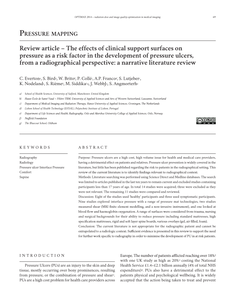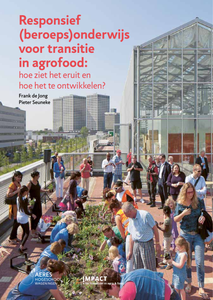Introduction: Pressure ulcers are a high cost, high volume issue for health and medical care providers, affecting patients’ recovery and psychological wellbeing. The current research of support surfaces on pressure as a risk factor in the development of pressure ulcers is not relevant to the specialised, controlled environment of the radiological setting. Method: 38 healthy participants aged 19-51 were placed supine on two different imaging surfaces. The XSENSOR pressure mapping system was used to measure the interface pressure. Data was acquired over a time of 20 minutes preceded by 6 minutes settling time to reduce measurement error. Qualitative information regarding participants’ opinion on pain and comfort was recorded using a questionnaire. Data analysis was performed using SPSS 22. Results: Data was collected from 30 participants aged 19 to 51 (mean 25.77, SD 7.72), BMI from 18.7 to 33.6 (mean 24.12, SD 3.29), for two surfaces, following eight participant exclusions due to technical faults. Total average pressure, average pressure for jeopardy areas (head, sacrum & heels) and peak pressure for jeopardy areas were calculated as interface pressure in mmHg. Qualitative data showed that a significant difference in experiences of comfort and pain was found in the jeopardy areas (P<0.05) between the two surfaces. Conclusion: A significant difference is seen in average pressure between the two surfaces. Pain and comfort data also show a significant difference between the surfaces, both findings support the proposal for further investigation into the effects of radiological surfaces as a risk factor for the formation of pressure ulcers.
DOCUMENT

Purpose: Pressure ulcers are a high cost, high volume issue for health and medical care providers, having a detrimental effect on patients and relatives. Pressure ulcer prevention is widely covered in the literature, but little has been published regarding the risk to patients in the radiographical setting. Thisreview of the current literature is to identify findings relevant to radiographical context.Methods: Literature searching was performed using Science Direct and Medline databases. The search was limited to articles published in the last ten years to remain current and excluded studies containing participants less than 17 years of age. In total 14 studies were acquired; three were excluded as they were not relevant. The remaining 11 studies were compared and reviewed.Discussion: Eight of the studies used ‘healthy’ participants and three used symptomatic participants. Nine studies explored interface pressure with a range of pressure mat technologies, two studies measured shear (MRI finite element modelling, and a non-invasive instrument), and one looked at blood flow and haemoglobin oxygenation. A range of surfaces were considered from trauma, nursing and surgical backgrounds for their ability to reduce pressure including standard mattresses, high specification mattresses, rigid and soft layer spine boards, various overlays (gel, air filled, foam).Conclusion: The current literature is not appropriate for the radiographic patient and cannot be extrapolated to a radiologic context. Sufficient evidence is presented in this review to support the need for further work specific to radiography in order to minimise the development of PU in at risk patients.
DOCUMENT

Description of a new hand/palm-held computerized 3D force measuring system. The system is built for interface (direct) measurement of 3D manual contact force with real-time data presentation. Static calibration was performed of the 3D force sensor with variable preloads to study their effect as well of the prototype system adapted for clinical manual examination and treatment. The new system enables, for the first time, recording and presenting of 3D manual contact forces at the patient-practitioner interface. 3D direct manual contact force measures have the potential to give a more complete and differentiated characterization of patient and practitioner forces than 1D forces. Clinical validity of the prototype system will have to be investigated, and for studying specific clinical manual handling techniques, obvious limitations require further development.
DOCUMENT

With the increased adoption of real-time objective measurements of player experience, advances have been made in characterising the dynamically changing aspects of the player experience during gameplay itself. A direct coupling to player action, however, is not without challenges. Many physiological responses, for instance, have an inherent delay, and often take some time to return to a baseline, providing challenges of interpretation when analysing rapidly changing gameplay on a micro level of interaction. The development of event-related, or phasic, measurements directly coupled to player actions provides additional insights, for instance through player modelling, but also through the use of behavioural characteristics of the human computer interaction itself. In this study, we focused on the latter, and measured keyboard pressure in a number of different, fast-paced action games. In this particular case, we related specific functional game actions (keyboard presses) to experiential player behaviour. We found keyboard pressure to be higher for avoidance as compared to approach-oriented actions. Additionally, the difference between avoidance and approach keyboard pressure related to levels of arousal. The findings illustrate the application potential of qualifying players’ functional actions at play (navigating in a game) and interpret player experience related to these actions through players’ real world behavioural characteristics like interface pressure.
MULTIFILE

Kleding vormt de interface tussen het menselijk lichaam en de leefomgeving. Kleding geeft mensen de mogelijkheid om hun identiteit en culturele achtergrond uit te drukken. Daarnaast heeft kleding vaak een beschermende rol, vooral tegen extreme weersomstandigheden zoals hoge en lage temperatuur, neerslag, wind, zonnestraling, maar ook tegen vuil, gifgas, kogels (zogenaamde ballistische bescherming), stoten, extreme druk, explosies e.d. Soms is kleding juist nodig om de omgeving af te schermen tegen vuil dat de mens produceert, zoals bij de productie van computerelektronica. Onder kleding wordt in deze verhandeling al het materiaal verstaan dat het menselijk lichaam omhult. Globaal betreft het voor het hoofd een hoofddeksel, voor de handen handschoenen of wanten, voor de voeten sokken en schoenen. Voor het boven- en onderlijf is meer keuze beschikbaar zoals een hemd, bh, Tshirt, polo, overhemd, trui, jas, onderbroek, broek en rok. Er zijn ook kledingstukken die boven- en onderlijf omspannen zoals een jurk, overall en lange jas. Bovendien is er een grote variatie binnen een categorie kledingstukken; hierbij kan onderscheid gemaakt worden in vorm, materiaal en kleur. In het lectoraat is gekozen voor drie speerpunten van onderzoek voor kleding/mode. Deze speerpunten zijn tot stand gekomen op basis van aanwezige expertise in de kenniskring van het lectoraat, analyse van kennislacunes en een inschatting van potentieel relevante maatschappelijke ontwikkelingen.
DOCUMENT

The promotor was Prof. Erik Jan Hultink and copromotors Dr Ellis van den Hende en Dr R. van der Lugt. The title of this dissertation is Armchair travelling the innovation journey. ‘Armchair travelling’ is an expression for travelling to another place, in the comfort of one’s own place. ‘The innovation journey’ is the metaphor Van de Ven and colleagues (1999) have used for travelling the uncharted river of innovation, the highly unpredictable and uncontrollable process of innovation. This research study began with a brief remark from an innovation project leader who sighed after a long and rough journey: ‘had I known this ahead of time…’. From wondering ‘what could he have known ahead of time?’ the immediate question arose: how do such innovation journeys develop? How do other innovation project leaders lead the innovation journey? And could I find examples of studies about these experiences from an innovation project leader’s perspective that could have helped the sighing innovation project leader to have known at least some of the challenges ahead of time? This dissertation is the result of that quest, as we do know relatively little how this process of the innovation project leader unfolds over time. The aim of this study is to increase our understanding of how innovation project leaders lead their innovation journeys over time, and to capture those experiences that could be a source for others to learn from and to be better prepared. This research project takes a process approach. Such an approach is different from a variance study. Process thinking takes into account how and why things – people, organizations, strategies, environments – change, act and evolve over time, expressed by Andrew Pettigrew (1992, p.10) as catching “reality in flight”.
MULTIFILE

Het zwaartepunt van de ingenieursopleiding is aan het verschuiven. De Utrechtse ingenieur zal zijn werk en toegevoegde waarde steeds meer vinden op het terrein van ontwerpen. Aan het ontwerpproces zelf worden steeds zwaardere eisen gesteld. Constructie en productie vinden in toenemende mate elders in de wereld plaats. Gelet op deze outsourcing zal de ontwerper ook in staat moeten zijn het maakproces op afstand te besturen, zowel wat betreft kwaliteit en geld als qua tijd. Ontwerpen kan vanuit verschillende perspectieven beschouwd worden: vanuit de conceptuele fase, de realisatiefase (verdere aanpassingen) of de gebruiksfase (upgrading, bediening et cetera). Bij onderzoeksinstellingen als TNO, maar ook bij vooraanstaande bedrijven als OCE, Philips en ASML zien we dat steeds meer sprake is van een integrale ontwerpaanpak. Het tijdperk van massaproductie evolueert naar een tijdperk van maatwerk, waarin de behoeften van de gebruiker centraal staan. De interactie tussen de technologie en de gebruiker zal een steeds belangrijker plaats in gaan nemen, en juist op dit vlak zal de Utrechtse ingenieur zich onderscheiden.
DOCUMENT

There is a wide range of literature suggesting that implicit learning is more effective than explicit learning when acquiring motor skills. However, the acquisition of nursing skills in educational settings continues to rely heavily on detailed protocols and explicit instructions. This study aimed to examine the necessity for comprehensive protocols in the acquisition of nursing skills. In the context of bandaging techniques, three studies were conducted to investigate whether students who practiced with an instruction card containing minimal instructions (implicit group) performed comparably to the students who practiced with a protocol containing step-by-step instructions (explicit group). Study 1 was designed to determine whether both groups performed equally well in applying a bandage during training. Study 2 and 3 were designed to determine if both groups performed equally well during a retention and transfer (multitasking) test, administered after a series of three training sessions. In comparison with the explicit group, the implicit group demonstrated comparable performance with their practice attempts in Study 1 and performed equally well during the retention and transfer test in Study 2. Furthermore, several results from Study 3 indicated better performance of the implicit group. In conclusion, the use of protocols with explicit step-by-step instructions may not be essential for the acquisition of nursing skills. Instead, instructional methods that facilitate implicit learning may be preferable, as students in the implicit group demonstrated at least comparable performance in all studies and tended towards greater consistency when multitasking.
DOCUMENT

Deze publicatie is een bundeling van de belangrijkste inzichten van het lectoraat ‘Responsief onderwijs voor transitie in agrofood’, uitgevoerd door Aeres Hogeschool Wageningen (AHW). Het lectoraat ontwikkelde tussen 2015 en 2019, samen met vier andere ‘groene’ lectoraten – binnen Aeres Hogeschool Dronten, Has Hogeschool, Hogeschool Inholland en Van Hall Larenstein – het lectoraatsprogramma ‘IMPACT: transitie in agrofood’. Het startpunt van de werkzaamheden in het lectoraat werd gevormd door de uitdagingen waarvoor de agrofood-sector ons stellen. Deze sector staat op het moment onder grote druk om duurzamer te worden, wat gepaard zal gaan met veranderingen. Deze publicatie en het AHW-lectoraat zijn gericht op de onderwijsvraagstukken die hiermee samenhangen, zoals: wat moeten toekomstige professionals kunnen? Hoe ziet het onderwijs dat daarop aansluit eruit? Hoe dient dit ontwikkeld te worden en wat is daarvoor nodig? In deze publicatie wordt een beeld geschetst van hoe het (beroeps)onderwijs voor transitie in agrofood er uit kan zien, gebaserend op de kennis en ervaring die opgedaan is in de onderzoeks- en onderwijspraktijk (op bachelor- en masterniveau), alsook tijdens het gedeelde IMPACT-programma.
DOCUMENT

Dit hoofdstuk volgt op het hierboven genoemde dat de achtergronden bespreekt van bij e-learning gebruikte softwaresystemen. Het inventariseert welke criteria gebruikt kunnen worden om uit concrete systemen te kunnen kiezen.
DOCUMENT
